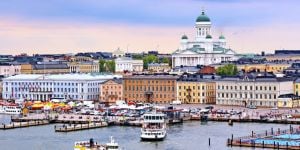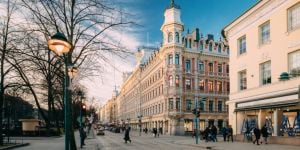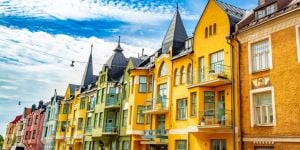
There is not only one Helsinki, but two. Or even three or four. There is winter, and there is summer. And spring and autumn. Four distinctive seasons. And they all have an effect on how you may want to spend your time in the city.
Islands around Helsinki
In the summertime, one should take advantage of the archipelago and its islands.
A must-see place is situated just a fifteen-minute boat ride from downtown. Suomenlinna (Castle of Finland), a sea fortress is nowadays a Unesco heritage site and definitely worth a trip for the history enthusiasts. Its caves and cannons and dockyards are certain to entertain kids as well.
Building the fortress was commenced by Sweden in 1748 to defend Helsinki against the Eastern threat of Russia. At that time, Finland, as we know it now, was part of the Swedish Empire. However, for the founders what followed was a bit embarrassing. During the Russo-Swedish War in 1808, the bastion surrendered without a shot being fired. Reasons for that humiliating capitulation are still not entirely clear. Suomenlinna continued as a military base under new rulers, the Russian Imperial Government.
In the 19th century, life in Suomenlinna was rather eventful apart from the Crimean War (1853-1856) when British and French fleet appeared in front of Helsinki and bombarded the fortress causing considerable damage.
Come the 20th century and history changes gear. That meant turbulent and often tragic times for Suomenlinna. In 1906, Russian soldiers revolted against their officers but were quickly crushed. After gaining independence in 1917, a bloody civil war soon broke out in Finland between the Whites and the Reds. The White army prevailed, and Suomenlinna was turned into a prison camp. Conditions for the 8,000 or so detainees were horrible. Diseases raged, and many were executed.
During the Second World War, the island was home to Finnish submarines and artillery units defending Helsinki. The Finnish Naval Academy is still situated there. Renovations are continuing to this day and nowadays Suomenlinna with its art exhibitions, cafes and restaurants is a pleasant destination – and weather allowing, an ideal place for picnics and sunbathing.
Another definite island to visit when days are long is the open-air museum Seurasaari. On the other end of the wooden bridge leading to the island, you will find rural Finland as it used to be. Since 1909, old wooden houses, barns, even a church, have been transported and re-erected on the 42-hectare island. The buildings are open during summertime, and there are guides to tell you more. And if history is not your thing, you can always feed the squirrels and ducks or even enjoy the sun on the nudist beach! Seurasaari Midsummer festival is a real Helsinki tradition.
Founded roughly around the same time with Seurasaari lies a third island destination for the whole family, just a short trip from the Market Square - Korkeasaari Zoo, one of the oldest of its ilk in the world. Even if you don't wish to see caged animals, nature and its diversity make the place worth a visit. And in case you are not planning to wander in the Finnish wilderness, this is a chance to meet bears, reindeers, elks and wolves eye to eye together with other 150 species.
Family activities in Helsinki
Do you wish to be a true Helsinki boy or a girl? Then, at least for once, you have to have a ride on the wooden rollercoaster of Linnanmäki, an amusement park. The park opened in 1950 and it has all the means to entertain you with stomach-turning devices. A must place to visit for those young at heart, it is open from late April till early October.
A less expensive (free) all family experience is to grab a sled and go screaming down the hills of Kaivopuisto or Paloheinä, if there happens to be snow. Later on, to warm up, it is not a bad idea to head towards Flamingo, a water park and spa close to the airport. The complex offers a variety of pools, saunas and treatments for the young and old.
Discover Helsinki's architecture
There are things to feed your mind, not only your body. Cultural events are many in Helsinki, but one thing remains and evolves: architecture.
Due to the sheer narrow mindedness and greed of city fathers and developers, many old buildings were torn down in the 1960s and in the 1970s. More destruction was caused than what the Russian bombers tried to do but failed. However, there are things to celebrate, old and new.
One can distinguish four architectural periods. The heart of the city around the Senate Square, its neo-classical appearance was designed by a German architect Carl Ludvig Engel. Arriving from St. Petersburg he was commissioned by the Russian Emperor to draw a new capital for the Grand Duchy in the early 19th century. No wonder, in the Hollywood film productions Helsinki has often played the role of St. Petersburg.
End of the 19th century, art nouveau and national romantic style began to take ground in architecture. Helsinki remains one of the best examples of that era and style - take a look at the Central Railway Station and the National Museum. Later on, surely the architect having the biggest influence on the city has been Alvar Aalto (1898-1976) whose modernist buildings have become landmarks. To mention a few, The Finlandia Hall, The House of Culture and the Academic Book Store.
Late 2010s the city has seen the rise of futuristic new constructions such as Amos Rex art museum and Oodi, the Central Library – both gaining international media coverage.
Learn more in our article "Things to do on weekdays in Helsinki".
Useful links:
We do our best to provide accurate and up to date information. However, if you have noticed any inaccuracies in this article, please let us know in the comments section below.








